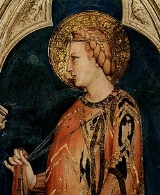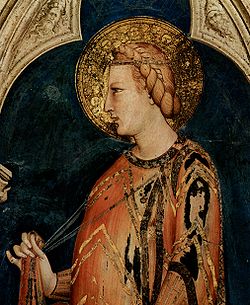
Hungary Water
Encyclopedia

Perfume
Perfume is a mixture of fragrant essential oils and/or aroma compounds, fixatives, and solvents used to give the human body, animals, objects, and living spaces "a pleasant scent"...
, claimed to date to about the late 14th century. According to legend it was first formulated at the command of a Queen of Hungary, sometimes identified as Isabella but usually as Elisabeth, or in one document "Saint Elisabeth, Queen of Hungary" (this may be a conflation of multiple individuals). These legends, and the documented references to this preparation, mostly date to the early to mid-17th century, so the details may have become confused in the intervening centuries.
The queen in question is frequently assumed to be Elisabeth of Poland
Elisabeth of Poland
Elisabeth of Poland was Queen consort of Hungary and regent of Poland. She is also known as Elisabeth of Kujavia and Elisabeth Piast.-Early life:...
(1305–1380), although the particulars of her life do not match those in the more common legends; it is even more unlikely that it could be Saint Elisabeth of Hungary
Elisabeth of Hungary
Elizabeth of Hungary, T.O.S.F., was a princess of the Kingdom of Hungary, Countess of Thuringia, Germany and a greatly-venerated Catholic saint. Elizabeth was married at the age of 14, and widowed at 20. She then became one of the first members of the newly-founded Third Order of St. Francis,...
(1207–1231), who is additionally too early and not a queen (note that the technique of distillation
Distillation
Distillation is a method of separating mixtures based on differences in volatilities of components in a boiling liquid mixture. Distillation is a unit operation, or a physical separation process, and not a chemical reaction....
only became well known in Europe between about 1150 and 1250). The only plausible Queen Isabella (late 13th century) likewise seems to be too early to be a strong candidate.
The exact date of the invention of Hungary water is lost to history. It is equally unclear who in particular created it. Some sources say that a monk-recluse who first gave it to Elizabeth, though most likely it was made by court alchemist (who could also have been a monk, thus reconciling the two traditions). The oldest surviving recipes call for distilling fresh rosemary
Rosemary
Rosemary, , is a woody, perennial herb with fragrant, evergreen, needle-like leaves and white, pink, purple or blue flowers, native to the Mediterranean region. It is a member of the mint family Lamiaceae, which includes many other herbs, and is one of two species in the genus Rosmarinus...
(and possibly thyme
Thyme
Thyme is a culinary and medicinal herb of the genus Thymus.-History:Ancient Egyptians used thyme for embalming. The ancient Greeks used it in their baths and burnt it as incense in their temples, believing it was a source of courage...
) with strong brandy
Brandy
Brandy is a spirit produced by distilling wine. Brandy generally contains 35%–60% alcohol by volume and is typically taken as an after-dinner drink...
, while later formulations contain lavender
Lavender
The lavenders are a genus of 39 species of flowering plants in the mint family, Lamiaceae. An Old World genus, distributed from Macaronesia across Africa, the Mediterranean, South-West Asia, Arabia, Western Iran and South-East India...
, mint, sage, marjoram
Marjoram
Marjoram is a somewhat cold-sensitive perennial herb or undershrub with sweet pine and citrus flavours...
, costus
Costus
Costus is a genus of perennial tropical herbaceous plants from the costus family . They are often characterized and distinguished from relatives such as Zingiber by their spiraling stems. The genus as a whole is thus often called spiral gingers, but this can also refer to C...
, orange blossom
Neroli
Neroli oil is a plant oil produced from the blossom of the bitter orange tree . Its scent is sweet, honeyed and somewhat metallic, whereas bergamot, being rich in linalool , has more of an aromatic, soft, floralcy.- Production :The blossoms are gathered, usually by hand, in late April to...
and lemon
Lemon
The lemon is both a small evergreen tree native to Asia, and the tree's ellipsoidal yellow fruit. The fruit is used for culinary and non-culinary purposes throughout the world – primarily for its juice, though the pulp and rind are also used, mainly in cooking and baking...
.
According to these same legends Hungary water first appeared outside of Hungary
Hungary
Hungary , officially the Republic of Hungary , is a landlocked country in Central Europe. It is situated in the Carpathian Basin and is bordered by Slovakia to the north, Ukraine and Romania to the east, Serbia and Croatia to the south, Slovenia to the southwest and Austria to the west. The...
in 1370 when the French Charles V le Sage
Charles V of France
Charles V , called the Wise, was King of France from 1364 to his death in 1380 and a member of the House of Valois...
, who was famous for his love of fragrances, received some.
Hungary water was known across Europe for many centuries, and until eau de Cologne
Eau de Cologne
Eau de Cologne or simply Cologne is a toiletry, a perfume in a style that originated from Cologne, Germany. It is nowadays a generic term for scented formulations in typical concentration of 2-5% essential oils. However as of today cologne is a blend of extracts, alcohol, and water...
appeared in the 18th century, it was the most popular fragrance and remedy applied. Similar to other herb and flower-based products, Hungary water was not merely (or even mainly) a fragrance, but also a valuable remedy; the early recipes advise the user to both wash with it and drink it in order to receive the most benefit.
The most valuable description of its attributes is in the "Pharmacopoeia Londinensis
Pharmacopoeia
Pharmacopoeia, pharmacopeia, or pharmacopoea, , in its modern technical sense, is a book containing directions for the identification of samples and the preparation of compound medicines, and published by the authority of a government or a medical or pharmaceutical society.In a broader sense it is...
" (1683) by Nicholas Culpeper
Nicholas Culpeper
Nicholas Culpeper was an English botanist, herbalist, physician, and astrologer. His published books include The English Physician and the Complete Herbal , which contain a rich store of pharmaceutical and herbal knowledge, and Astrological Judgement of Diseases from the Decumbiture of the Sick ,...
:
"The water (containing an infusion of spirits) is admirable cure-all remedy of all kinds of cold and humidity-induced head ailments, apoplexies, epilepsies, dizziness, lethargy, crippleness, nerves diseases, rheumatism, flaws, spasms, loss of memory, coma, drowsiness, deafness, ear buzzing, derangement of vision, blood coagulation, mood-induced headaches headaches. Relieves toothache, useful for stomach cramps, pleuritis, lack of appetite, indigestion, obstruction of the liver, obstruction of the spleen, intestinal obstruction and contraction of the uterus. It receives and preserves natural heat, restores body functions and capabilities even at late age (saying has it). There are not many remedies producing that many good effects. Use internally in wine or vodka, rinse temples, breath in with your nose."

